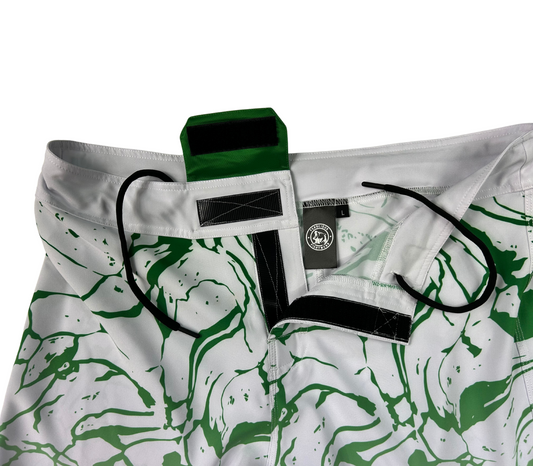When should a UFC champion be stripped of their belt? A Delicate Procedure
In the fast-paced world of MMA, the UFC occasionally finds itself grappling with the intricate question of when and why to strip a champion of their hard-earned title belt. This process, while not common, has significant implications for both the organization and the fighters involved. Understanding the procedure, its precedents, and the role of interim champions sheds light on the complexities of maintaining order and fairness in the octagon. Given the recent trending championship belt love triangle between Jon Jones, Stipe Miocic and Tom Aspinall we thought it might be a good time to take a deep dive into the procedures and precedents involved in a situation like this.
One thing that is clear, Interim champions play a crucial role in the UFC ecosystem, stepping in to keep the division moving forward when the reigning champion is unable to defend their title. While interim belts may not carry the same prestige as undisputed titles, they provide an opportunity for fighters to showcase their skills on a larger stage and position themselves for a title shot upon the champion's return.
Stripping a champion of their belt is a decision not taken lightly by the UFC. It typically occurs when a champion is unable to defend their title within a reasonable timeframe due to injury, contractual disputes, or other extenuating circumstances. The UFC must balance the interests of the champion, the challengers, and the fans in making this determination. It is important that a division is not delayed so that other fighters have the opportunity to prove themselves as the best in the world while it is also important to respect the previous efforts made by the current champion to obtain their hard earned belt in the first place.
The decision the UFC takes in circumstances like this are particularly important because, as the leading organisation within the sport they often set a precedent and the rest of the industry tends to follow suit.
Historically, the UFC has followed a set of guidelines rather than rigid rules when considering stripping a champion. Factors such as the severity of the champion's injury, the expected duration of their absence, and the availability of suitable contenders play a crucial role in the decision-making process.
Precedents:
Conor McGregor - 2016:
Several notable instances in UFC history illustrate the stripping of champions for various reasons. One such example is the case of Conor McGregor, who was stripped of his featherweight title in 2016 due to inactivity in the division while pursuing other ventures. McGregor won his featherweight title against José Aldo on the 12th December 2015 and was stripped on November 26, 2016. This was an unusual occurrence as even though McGregor was inactive in the featherweight division he was not injured nor was he unactive in MMA. During the time since winning his featherweight title McGregor had 2 bouts at welterweight against Nate Diaz and one bout at lightweight against Eddie Alvarez.
9 months after winning the featherweight title McGregor fought Floyd Mayweather in boxing and has never returned to featherweight since being stripped. It is well known that McGregor had difficulties making featherweight so this could also possibly be a factor in his decision to not return to the weightclass.
Robert Whittaker - 2019:
Robert Whittaker was stripped of his UFC middleweight title on October 6, 2019. Whittaker's title reign faced a significant setback when he was scheduled to defend his championship against Kelvin Gastelum at UFC 234 on February 9, 2019, in Melbourne, Australia. However, Whittaker was forced to withdraw from the fight just hours before the event due to a severe abdominal injury that required emergency surgery. This unexpected turn of events left the UFC without a main event for UFC 234.
Whittaker's injury and subsequent withdrawal from UFC 234 marked the beginning of a prolonged period of inactivity for the middleweight champion. As Whittaker focused on his recovery and rehabilitation, the UFC was faced with the challenge of determining the future of the middleweight division in his absence.
Despite Whittaker's status as the reigning champion, the UFC opted to maintain the momentum of the middleweight division by crowning an interim champion. At UFC 236 on April 13, 2019, an interim middleweight title fight was scheduled between Kelvin Gastelum and Israel Adesanya. Adesanya emerged victorious in a thrilling five-round battle, securing the interim championship and solidifying his status as one of the division's top contenders.
As Whittaker continued his recovery and rehabilitation, the UFC closely monitored his progress and awaited his return to competition. However, as months passed without a clear timeline for Whittaker's comeback, the UFC ultimately made the decision to strip him of the middleweight title.
The decision to strip Whittaker of the title was not taken lightly by the UFC, but it was deemed necessary to ensure the continued competitiveness of the middleweight division. With Whittaker unable to defend his title within a reasonable timeframe due to injury, the interim champion, Israel Adesanya, was elevated to undisputed champion status.
Whittaker was given an immediate chance to regain his title, he faced Adesanya on the 5th October 2019 in a bout that lasted 2 rounds with Adesanya reigning victorious.
This particular instance is perhaps the best example of how the process can be managed, the division was able to continue and the champion who was stripped of their title was given an immediate bout on their return.
Jiri Prochazka - 2022:
While Jiri Prochazka was not stripped of his title he did however vacate his title in November 2022. Prochazka who is known as a traditional martial artist who lives by a self proclaimed “warriors code” and is known for undertaking unusual alternative training methods vacated the title because he did not want to hold up the division. The impact of this gesture was long lasting as the following year Jamahal Hill also vacated the title in July 2023 when he himself was injured after having been inspired by Jiri.
The Current Heavyweight Predicament:
While the examples above are all different to each other they serve to further demonstrate that this issue is not a linear issue nor is it an easy one to solve.
In the current heavyweight division we have a situation whereby Jon Jones is the current champion who was set to face heavyweight legend Stipe Miocic on the 11th November 2023 for the belt, however at the end of October just weeks before the fight Jones was injured during training and it is estimated he could be out for a total of 9 months. The UFC in an effort to save the card featured an Interim title belt between perhaps the two most promising heavyweight contenders, Tom Aspinall and Sergei Pavlovich. Aspinall emerged victorious and we are now faced with a situation whereby Jones is reluctant to relinquish his belt and Aspinall is not keen to wait over a year to defend his belt against the winner of Jones vs Miocic when the bout will later be re-scheduled.
This is where the predicament gets further complicated, it is rumoured that Jones and Miocic may be keen to both retire after this bout which features two of the greatest champions the UFC has ever seen and both see this bout as a potential legacy fight. Miocic is rumoured to be reluctant to fight Aspinall and Aspinall has stated online that he is not keen to defend his interim belt but would prefer to fight for the heavyweight championship as is usually the procedure that the interim champion is to fight the current heavyweight champion for the undisputed belt.
In this particular instance UFC president Dana White has made it clear that he plans to have Jones face Miocic when Jones recovers as this is a fight the UFC has been trying to make for many years and he does not want to see the opportunity be missed.
This example further demonstrates the complicated process of running an elite mixed martial arts organisation and the constant ongoing battle to try to keep all parties happy which seems to be a somewhat impossible task at the best of times.
Stripping a champion of their belt in the UFC is a nuanced process that requires careful consideration of multiple factors. While the organization has established precedents for such actions, each case presents its own unique challenges and circumstances. Interim champions play a vital role in maintaining the integrity of the divisions during periods of champion absence, ensuring that the UFC remains a dynamic and competitive sport.
As the sport continues to evolve, the UFC must navigate the delicate balance between respecting its champions' achievements and upholding the principles of fairness and competition. Ultimately, the decision to strip a champion of their belt is a reflection of the organization's commitment to the sport's long-term success and the satisfaction of its passionate fan base.




